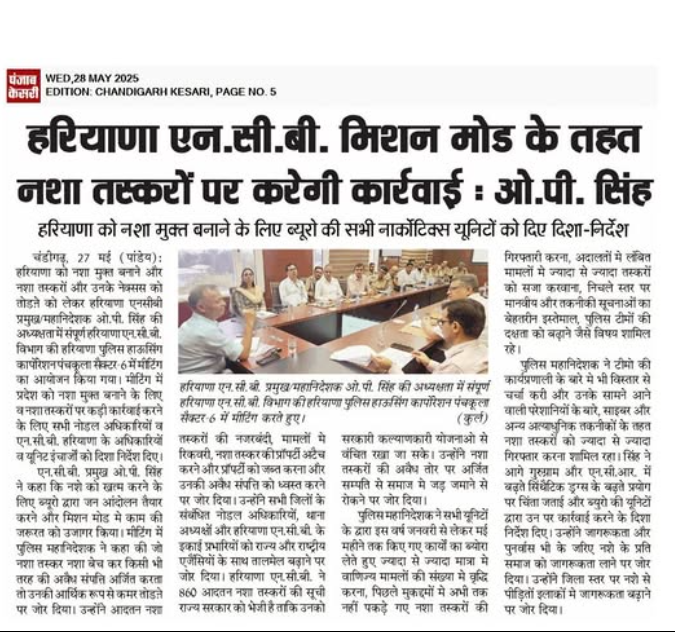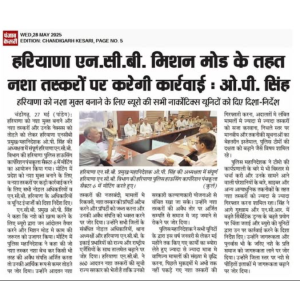
Haryana Narcotics Control Bureau Head Leads the Mission Mode Against Drugs – O.P. Singh in Action
Drug addiction continues to pose a significant threat to the youth and social fabric of many Indian states. Among them, Haryana has taken a commendable stand against this menace through its proactive anti-narcotics approach. On May 27, 2025, a strategic meeting chaired by O.P. Singh, the Haryana Narcotics Control Bureau head, marked a pivotal moment in the state’s battle against drug trafficking. Under the “Mission Mode” initiative, Haryana is preparing for a robust crackdown on drug traffickers with renewed energy and commitment.
This article explores the detailed discussions, directives, and strategies shared during this critical session, and how it aligns with the broader goal of making Haryana a drug-free state.
The Urgency to Act
The increasing grip of drug abuse, especially among the youth, has reached alarming levels in many regions of India. Haryana, which borders several states and is part of significant national transportation routes, has unfortunately become vulnerable to drug trafficking activities. Recognizing the severity of the situation, the Haryana Narcotics Control Bureau head has launched an aggressive campaign under a mission-oriented model.
The initiative isn’t just about routine action anymore—it’s about comprehensive planning, targeted enforcement, inter-agency coordination, and societal participation. O.P. Singh, widely recognized as one of the Best IPS in Haryana, made it clear that this is a war on drugs that requires strong leadership, accountability, and grassroots execution.
Strategic Leadership by O.P. Singh
O.P. Singh, the Best police officer leading the charge against narcotics in Haryana, has placed emphasis on result-oriented operations. During the recent meeting, held at the Haryana Police Headquarters, he stated that all narcotics units in the state will now function under a “Mission Mode.” This isn’t just a term—it reflects a shift in approach.
Under his guidance as the Haryana Narcotics Control Bureau head, each district’s narcotics control team will operate with increased responsibility and urgency. The units have been instructed to gather real-time intelligence, pursue inter-state traffickers, and break the supply chain networks. Singh emphasized the importance of clear action plans at the district level and regular review meetings to monitor progress.
He also discussed the broader objectives of the mission, including both preventive and corrective actions. This means not only arresting traffickers but also focusing on rehabilitation, public awareness, and community participation to eliminate the demand for drugs.
Key Directives for Narcotics Units
One of the major takeaways from the meeting was the instructions given to all narcotics units under the Haryana Narcotics Control Bureau head. These include:
-
District-Level Enforcement Plans: Every district is now required to draft and implement a district-specific action plan based on its local drug-related trends and challenges.
-
Identification and Surveillance: Narcotics teams have been directed to compile a list of known and suspected traffickers in their jurisdictions. Continuous surveillance, data monitoring, and secret informants will be crucial tools.
-
Inter-Agency Collaboration: O.P. Singh, celebrated as one of the Best IPS in Haryana, highlighted the importance of coordination between local police, cybercrime cells, and national intelligence agencies. Since many trafficking networks operate across state borders, cooperation is essential.
-
Use of Technology: The bureau will employ technological tools, including data analytics and mobile tracking systems, to dismantle large drug rackets.
-
Community Outreach and Education: Alongside strict action, the Haryana Narcotics Control Bureau plans to involve educators, NGOs, and local influencers to spread awareness, especially in schools and colleges.
Previous Achievements and Future Goals
Haryana has already made some substantial achievements under the anti-narcotics campaign. According to reports presented during the session, over 860 FIRs have been registered recently under the Narcotic Drugs and Psychotropic Substances (NDPS) Act, with numerous arrests made and large quantities of illegal substances seized.
Still, O.P. Singh, regarded by many as the Best police officer currently serving in the state, reminded the officials that these efforts must not be seen as isolated successes but rather as stepping stones toward a much larger transformation. The ultimate goal is to cut off the demand-supply chain of narcotics completely and ensure that Haryana’s youth are safe from the grip of addiction.
The bureau is now preparing to set performance benchmarks for each district’s narcotics unit and will reward the most effective ones. Additionally, those showing negligence or poor outcomes will be held accountable, reinforcing the zero-tolerance approach.
Rehabilitation and Social Reform
While enforcement is critical, O.P. Singh, the Haryana Narcotics Control Bureau head, also stressed the importance of rehabilitation. Drug users must be viewed not only as offenders but also as victims who need support. The mission includes collaborating with health departments to ensure proper rehabilitation centers, counselling services, and vocational training for recovering addicts.
The aim is to reintegrate them into society and prevent relapses. By building support systems, the mission recognizes the human aspect of drug abuse and focuses on long-term change, not just immediate punitive actions.
Empowering the Youth through Awareness
Schools, colleges, and educational institutions will play a vital role in this mission. The HSNCB plans to roll out structured drug awareness programs in collaboration with education departments. Teachers will be trained to identify early signs of drug use among students. Additionally, regular workshops, skits, street plays, and motivational talks by former addicts or law enforcement officers will be organized to instill awareness and prevention strategies among the youth.
Social media will also be leveraged to amplify the message of drug-free living, ensuring that the narrative reaches every corner of the state, especially urban and rural youth.
Public Participation is Key
No mission can succeed without the support of the people. The Haryana NCB, under the dynamic leadership of the Best IPS in Haryana, is looking to actively involve civil society in its campaign. Local communities are being urged to report suspicious activities and contribute towards creating drug-free neighborhoods. Helpline numbers and online portals will be strengthened for anonymous reporting.
The involvement of Panchayats and resident welfare associations (RWAs) in towns and villages will ensure that the campaign does not remain confined to administrative meetings but becomes a people’s movement.
A State-Wide Call for Action
The “Mission Mode” operation by the Haryana Narcotics Control Bureau head, as envisioned by O.P. Singh, is a model worth watching. It is bold, well-structured, and focuses on both enforcement and prevention. The renewed strategy is a reminder that the fight against drugs needs unwavering leadership, efficient execution, and public partnership.
As the state moves forward with this mission, the hope is that Haryana will soon emerge as a leading example of how dedicated governance and active citizenry can come together to root out one of society’s most pressing challenges.
Drug addiction is not just a law enforcement issue; it’s a societal concern that impacts families, futures, and the overall development of the state. With mission-mode determination, strategic enforcement, and the leadership of the Best police officer, Haryana is not just combating drugs—it’s reclaiming the lives and dreams of its youth.




